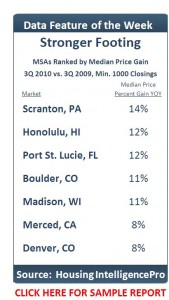Written by Jonathan Dienhart and Ken Lee courtesy of Hanley Wood Marketing Intelligence
Median home prices seem to have finally begun to stabilize in 2010 in many markets across the nation. While sales volumes remain lackluster at best, record-low mortgage rates and a slowly improving economy have helped stopped the precipitous decline of home prices in most areas. Our data feature of the week, courtesy of Housing IntelligencePro, focuses on the markets that were fortunate to see the largest increase in median price from a year ago. For metro areas that recorded at least 1,000 closings during the quarter, Scranton, PA showed the largest year-over-year gains during the third quarter, with a median sales prices increase of 14% from year-ago levels. Major metropolitan areas in Colorado were the steadiest with 5 out of the top 20 price performers in the “Rocky Mountain State”. Boulder (#4), Denver (#7), Colorado Springs (#9) were all in the top 10 while Fort Collins was ranked 15th and Greeley ranked 19th.
In broader housing news, fixed mortgage rates set another all-time low this past week as the Federal Reserve announced another round of quantitative easing. Treasury prices fell on Friday, pushing up yields as the Fed began its campaign to buy back additional government debt. The jump in bond yields will likely exert pressure on mortgage rates over the coming week.
In a relatively light week for economic data, broader equity prices retreated amid cautiousness after the recent bull-run. A slightly better than expected reading on consumer sentiment is a positive sign for the economy going into the busy holiday shopping season. With the U.S. unemployment rate at 9.6% and the underemployment rate hovering at around 17%, it will be interesting to see how the consumer spends this holiday season. Weaker earnings out of the technology sector also helped push equity prices lower this past week.
The Economy
The Reuters/University of Michigan consumer sentiment index rose more than expected in November as we approach the key holiday shopping season for retailers. The index increased to a reading of 69.3 which was higher than a reading of 67.7 last month in October. This is the highest reading for the index since June.
After experiencing a setback last week, first-time jobless claims declined again over the past week. Initial unemployment claims fell by 24,000 in the week ended November 6th to a seasonally-adjusted figure of 435,000. Unemployment claims have fluctuated up and down over the past few weeks. Despite experiencing a gradual decline over the past couple of months, jobless claims remain at distressed levels that will not help improve overall labor market conditions.
Housing Market
National average mortgage rates declined from the previous week to 4.17% in the latest Primary Mortgage Market Survey released weekly by Freddie Mac on November 11th. After increasing for the previous three consecutive weeks, fixed mortgage rates dropped to new all-time record lows this past week. Mortgage rates have now averaged less than 5.0% for 27 straight weeks.
In the week ending November 5th, the MBA’s seasonally-adjusted purchase index increased 5.48% from the previous week but was down 14.58% compared to the same time last year. This is the third straight week that the purchase index has increased. However, the index still remains near 14-year lows.

Recent Comments